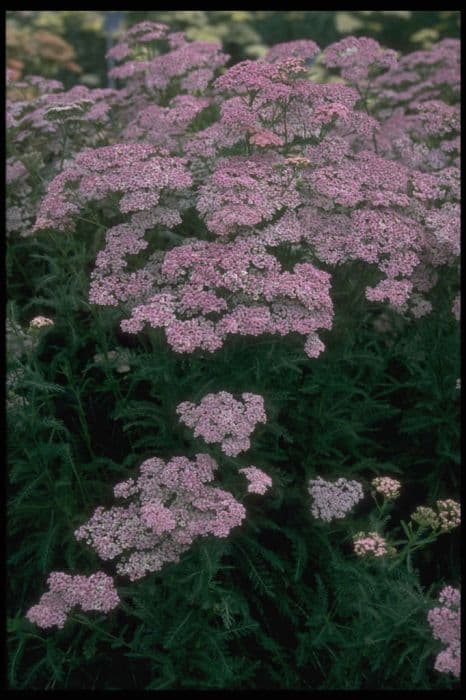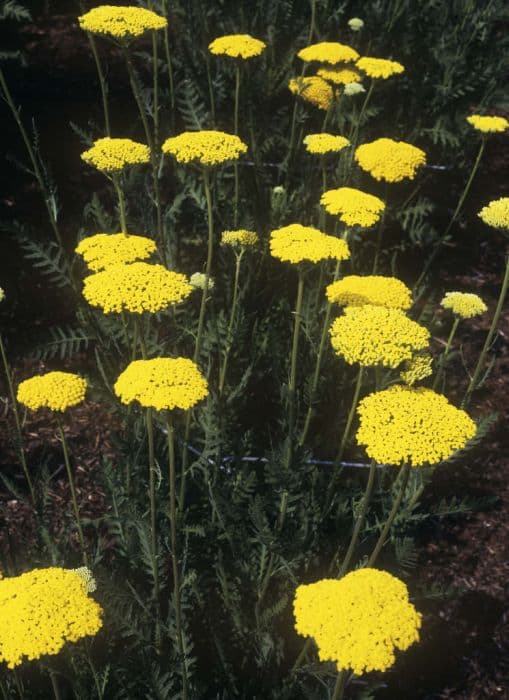Threadleaf Coreopsis Coreopsis verticillata 'Bengal Tiger' (PBR)

ABOUT
The Coreopsis verticillata 'Bengal Tiger', commonly known as Tickseed 'Bengal Tiger', is a visually striking perennial plant that is admired for its vibrant floral display. It features an abundance of daisy-like flowers, which boast a lively color palette that mimics the fiery hues of a Bengal tiger's coat. The blooms have a rich, golden-yellow base with pronounced, reddish-brown markings that radiate from the center disk, creating a striking contrast that is quite eye-catching in any garden setting. The foliage of the Tickseed 'Bengal Tiger' is equally appealing, with fine, needle-like leaves that create a delicate and airy texture. The leaves are arranged in a whorled pattern, adding to the visual interest of the plant. Their color is a deep green, which serves as an excellent backdrop for the luminous flowers, highlighting their warm shades and making the plant a standout in the landscape. As a garden plant, the Tickseed 'Bengal Tiger' flowering period typically extends from early summer to fall, providing a long-lasting display of color that can rejuvenate and brighten garden beds, borders, and containers. The continued bloom coupled with the plant's attractive foliage ensures a sustained ornamental contribution to any garden. Additionally, the flowers are known to attract pollinators such as butterflies and bees, adding an ecological benefit as well as liveliness to the garden atmosphere. Overall, the Tickseed 'Bengal Tiger' offers both exceptional beauty and a hardy, resilient nature that makes it a favored choice among garden enthusiasts.
About this plant
 Names
NamesFamily
Asteraceae.
Synonyms
Threadleaf Coreopsis, Whorled Tickseed, Needle Tickseed, Thread Leaved Tickseed, Fern-leaf Tickseed.
Common names
Coreopsis verticillata 'Bengal Tiger' (PBR)
 Toxicity
ToxicityTo humans
The plant known as Threadleaf Coreopsis is not generally considered toxic to humans. There is no widespread documentation of toxicity or symptoms associated with poisoning from the ingestion of this plant. However, individual allergies and adverse reactions to plants can vary, so it is always best to avoid ingesting any plant not known to be safe for consumption.
To pets
Threadleaf Coreopsis is also not generally recognized as toxic to pets, including cats and dogs. It is not known to cause serious illness or pose any significant risks if pets happen to ingest it. As with humans, pets may have individual sensitivities, so monitoring for signs of distress after ingestion is advisable, but there are no well-documented cases of poisoning from this plant in pets.
 Characteristics
CharacteristicsLife cycle
Perennials
Foliage type
Deciduous
Color of leaves
Green
Flower color
Yellow
Height
1-3 feet [30-91 cm]
Spread
1-2 feet [30-61 cm]
Plant type
Herb
Hardiness zones
5
Native area
North America
Benefits
 General Benefits
General Benefits- Attracts Pollinators: Coreopsis verticillata 'Bengal Tiger' is known to attract bees and butterflies, promoting pollination in the garden.
- Drought Tolerant: Once established, it can withstand periods of low rainfall, making it suitable for water-wise gardens.
- Long Blooming: It has a lengthy flowering season, providing vibrant colors from early summer into fall.
- Low Maintenance: This plant requires minimal care once established, making it a convenient choice for busy gardeners.
- Resistant to Pests: It is generally resistant to many common garden pests, reducing the need for chemical treatments.
- Deer Resistant: Its foliage and flowers are not preferred by deer, which helps to keep them away from the garden.
- Easy to Propagate: It can be easily propagated from seed or by dividing the plant, allowing gardeners to expand their display.
- Adaptable: It can adapt to a variety of soil conditions, though it prefers well-drained soils.
- Enhances Garden Aesthetics: With its striking yellow and red flowers, it is a beautiful addition to any flower bed, border, or container.
- Supports Biodiversity: By attracting pollinators, it plays a role in supporting local ecosystem biodiversity.
 Medical Properties
Medical PropertiesThis plant is not used for medical purposes.
 Air-purifying Qualities
Air-purifying QualitiesThis plant is not specifically known for air purifying qualities.
 Other Uses
Other Uses- Coreopsis verticillata 'Bengal Tiger', commonly known as threadleaf coreopsis, can be used as a natural fabric dye, giving textiles a warm golden-yellow hue.
- The dried flower petals of threadleaf coreopsis can be used in potpourri mixtures, adding both color and a subtle fragrance to the mix.
- Threadleaf coreopsis can serve as an educational tool in schools to teach children about pollination and the role of native flora in supporting wildlife.
- As a model in photography, the striking patterns of threadleaf coreopsis add aesthetic value and can be used for botanical illustrations or garden photography workshops.
- This plant can be used in floral art, where its vivid colors and unique form can be preserved in pressed flower arrangements or decorative crafts.
- Threadleaf coreopsis is suitable for creating eco-friendly confetti, as petals are biodegradable and much better for the environment than traditional paper or plastic variants.
- Gardeners may use the threadleaf coreopsis in companion planting to attract beneficial insects that prey on pests harmful to vegetables and other plants.
- The bright flowers of the threadleaf coreopsis can be used to create natural, visually appealing borders along sidewalks and paths without the use of artificial materials.
- Threadleaf coreopsis serves as an inspiration for artists and designers, influencing patterns in fashion, textiles, and even architectural elements.
- In culinary presentations, the vibrant blooms of threadleaf coreopsis can be used as an edible garnish to embellish salads and desserts, though they should be used sparingly and only if confirmed safe for consumption.
Interesting Facts
 Feng Shui
Feng ShuiThe Threadleaf Coreopsis is not used in Feng Shui practice.
 Zodiac Sign Compitability
Zodiac Sign CompitabilityThe Threadleaf Coreopsis is not used in astrology practice.
 Plant Symbolism
Plant Symbolism- Cheerfulness: Coreopsis, often known as Tickseed, is frequently associated with cheerfulness due to its bright and vibrant yellow flowers that are reminiscent of a sunny disposition.
- Optimism: The vivid colors of the Tickseed can signify a sense of optimism, symbolizing a perspective that looks on the bright side of life.
- Love: In some traditions, giving someone Coreopsis is a way to express one's undying love, possibly due to the persistent blooming of these hearty flowers.
- Resourcefulness: The adaptability and resilience of Tickseed could represent resourcefulness, as this plant is able to thrive in a variety of conditions and signifies an ability to adjust and succeed.
 Water
WaterThreadleaf coreopsis, including the 'Bengal Tiger' cultivar, prefers consistent moisture but is quite drought tolerant once established. During the growing season, water the plant deeply once a week, providing about 1 to 1.5 gallons per plant. Ensure that the soil is well-draining to prevent waterlogging. In hot, dry periods, you may need to increase watering frequency, but always check the soil moisture before doing so—a finger's depth into the soil should feel dry before watering again. During winter or periods of rainfall, reduce watering to prevent rot.
 Light
LightThreadleaf coreopsis thrives in full sun but can tolerate light shade. The best spot for 'Bengal Tiger' is in an area where it can receive at least 6 to 8 hours of direct sunlight per day. Avoid deep shade, as this can lead to leggy growth and fewer flowers.
 Temperature
TemperatureThreadleaf coreopsis 'Bengal Tiger' performs well in a wide range of temperatures, tolerating minimum temperatures down to around -30 degrees Fahrenheit. It thrives in regions where summer temperatures do not consistently exceed 90 degrees Fahrenheit. Providing the plant with an ideal growing environment would include temperatures between 60 and 80 degrees Fahrenheit.
 Pruning
PruningTo encourage bushy growth and continuous blooming, prune Threadleaf coreopsis ‘Bengal Tiger’ periodically. Deadhead spent flowers regularly throughout the blooming season to promote more blooms. In early spring or late fall, cut back the foliage to about 3 to 4 inches above the ground to help rejuvenate the plant and maintain a tidy appearance. The best time for substantial pruning is in late winter or early spring, before new growth begins.
 Cleaning
CleaningAs needed
 Soil
SoilThreadleaf coreopsis thrives best in a well-draining soil mix with a pH ranging from 5.0 to 7.0. A mix of garden soil, compost, and perlite or coarse sand is ideal to ensure proper drainage and fertility for robust growth.
 Repotting
RepottingThreadleaf coreopsis doesn't require frequent repotting and can be done every 2-3 years or when the plant outgrows its current pot, to refresh the soil and provide space for further growth.
 Humidity & Misting
Humidity & MistingThreadleaf coreopsis is quite tolerant of a range of humidity levels and does well in average outdoor conditions, without the need for specific humidity adjustments.
 Suitable locations
Suitable locationsIndoor
Ensure bright light, well-draining soil; minimal indoor.
Outdoor
Plant in full sun, well-draining soil; water moderately.
Hardiness zone
5-9 USDA
 Life cycle
Life cycleCoreopsis verticillata 'Bengal Tiger', commonly known as threadleaf coreopsis or whorled tickseed, begins its life cycle as a seed that germinates in late spring when soil temperatures are warm. The seedling emerges and develops into a young plant with a characteristic fine, fern-like foliage. During its vegetative stage, the plant establishes a strong root system and foliage that grows in a clumping habit. Flowering typically occurs in the summer, displaying bold, bicolored red and yellow flowers that attract pollinators and are suitable for cutting. After pollination, the plant sets seed which can be collected and dispersed, enabling new plants to grow the following season. This perennial plant will go dormant in the fall and winter, dying back to the ground in colder climates, and will re-emerge from its rootstock in the spring to repeat its life cycle.
 Propogation
PropogationPropogation time
Spring-Early Summer
Coreopsis verticillata 'Bengal Tiger', commonly known as Threadleaf Coreopsis or Whorled Coreopsis, is most effectively propagated by division. The ideal time for this is in early spring or late fall. To propagate by division, dig up an established clump and gently separate it into sections, ensuring each section has a portion of the root system attached. These divisions can then be replanted at the same soil depth they were originally growing. Thorough watering after replanting helps to establish the new divisions. This method allows for the preservation of the specific characteristics of the 'Bengal Tiger' cultivar, which might not be true if propagated by seed.









